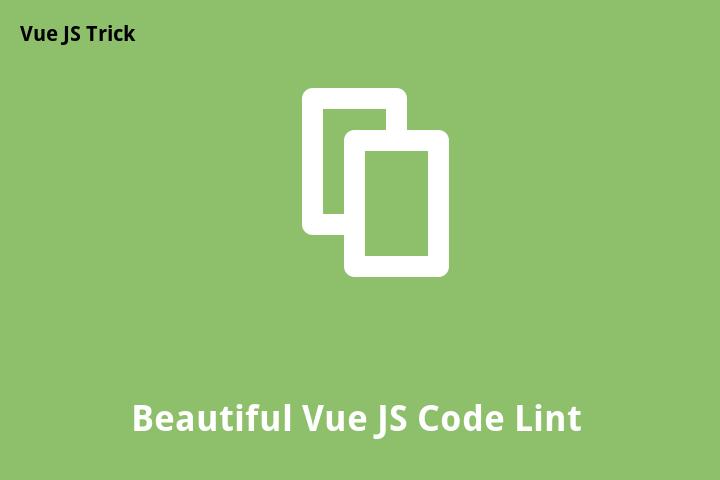Beautiful Vue JS Code Lint
If you’re working with Vue JS, then you know how important it is to have clean and beautiful code. Code that is easy to read, easy to understand, and easy to maintain. To achieve this, you need a good code linter. In this article, we’ll take a look at some of the best linters for Vue JS and how to configure them to ensure that your code is flawless.
What is a Code Linter?
A code linter is a tool that analyzes your code and flags any issues or errors. It can help you catch potential bugs before they cause problems, and ensure that your code adheres to best practices and coding standards. A linter goes through your code looking for syntax errors, typos, unused variables, and other issues that might affect the quality of your code.
Why Use a Code Linter?
There are many reasons why you should use a code linter:
- It helps you catch errors and bugs before they cause problems
- It ensures that your code adheres to best practices and coding standards
- It improves the readability and maintainability of your code
- It helps you write more efficient and optimized code
Best Linters for Vue JS
Vue JS is a popular front-end framework, and there are several linters available that are specifically designed to work with Vue. Here are some of the best ones:
1. ESLint
ESLint is a widely used code linter that supports Vue JS out of the box. It can analyze your code for errors, style issues, and potential bugs. It’s highly customizable, so you can configure it to suit your specific needs. You can add plugins and extend its capabilities with rules that match your coding style.
// Install ESLint and the Vue plugin
npm install eslint --save-dev
npm install eslint-plugin-vue --save-dev
// Create an .eslintrc file with the following content
{
"plugins": ["vue"],
"extends": ["eslint:recommended", "plugin:vue/recommended"]
}
2. Vue ESLint
Vue ESLint is a plugin that extends the capabilities of ESLint to work specifically with Vue JS. It adds rules for Vue-specific syntax and features, such as the template syntax and Vue component options. It can also detect common errors and best practices that are specific to Vue.
// Install Vue ESLint
npm install eslint-plugin-vue --save-dev
// Create an .eslintrc file with the following content
{
"plugins": ["vue"],
"extends": ["plugin:vue/recommended"]
}
3. Vetur
Vetur is a VS Code plugin that offers syntax highlighting, autocomplete, and linting for Vue JS. It supports Vue templates, Vue components, and Vue files, and offers integration with other tools, such as ESLint and Prettier. It’s a great tool for developers who use VS Code as their primary code editor.
Configuring Your Linter
Once you’ve installed your linter of choice, you’ll need to configure it to work with your code editor or build system. Typically, this involves creating a configuration file, such as .eslintrc for ESLint or vetur.config.js for Vetur, and specifying the rules and options that you want to use.
To ensure that your code is beautiful and flawless, it’s a good idea to use a combination of linters and tools. For example, you might use ESLint to detect syntax errors and style issues, Prettier to format your code automatically, and Vetur to provide syntax highlighting and autocomplete in VS Code.
Conclusion
Code linting is an essential tool for any developer who wants to write beautiful, efficient, and maintainable code. By using a good linter that is specifically designed to work with Vue JS, you can catch potential bugs before they cause problems, ensure that your code adheres to best practices and coding standards, and improve the readability and maintainability of your code. With the right tools and techniques in place, you can write code that is not only functional but also beautiful and flawless.
FAQs
1. What are the benefits of using a code linter?
Using a code linter can help you catch errors and bugs before they cause problems, ensure that your code adheres to best practices and coding standards, improve the readability and maintainability of your code, and help you write more efficient and optimized code.
2. What is the best linter for Vue JS?
There are several linters available for Vue JS, including ESLint, Vue ESLint, and Vetur. Each has its own strengths and weaknesses, so it’s important to choose the one that best suits your needs.
3. How do I configure my code linter?
To configure your code linter, you’ll need to create a configuration file and specify the rules and options that you want to use. This will depend on the linter and the specific tools and techniques that you want to use.
4. Can I use multiple linters at the same time?
Yes, you can use multiple linters and tools at the same time to improve the quality and readability of your code. For example, you might use ESLint to detect syntax errors and style issues, Prettier to format your code automatically, and Vetur to provide syntax highlighting and autocomplete in VS Code.
5. How do I know if my code is beautiful?
Your code is beautiful if it’s easy to read, easy to understand, and easy to maintain. It should follow best practices and coding standards, have no syntax errors, and be optimized for performance. By using a good code linter and other tools, you can ensure that your code is flawless and beautiful.

